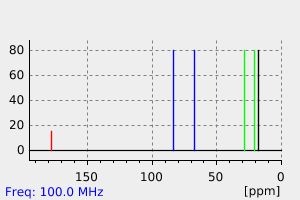5-羟基-4-己内酯 | 27610-27-1
中文名称
5-羟基-4-己内酯
中文别名
4,5-二羟基己酸-γ-内酯二氢-5-(1-羟基乙基)-2(3H)-呋喃酮
英文名称
5-(1-hydroxyethyl)dihydrofuran-2(3H)-one
英文别名
5-(1-hydroxy-ethyl)-dihydro-furan-2-one;5-(1'-Hydroxyethyl)dihydro-2(3H)-furanon;5-(1-Hydroxyethyl)oxolan-2-one
CAS
27610-27-1
化学式
C6H10O3
mdl
——
分子量
130.144
InChiKey
KBLZKAKKJPDYKJ-UHFFFAOYSA-N
BEILSTEIN
——
EINECS
——
-
物化性质
-
计算性质
-
ADMET
-
安全信息
-
SDS
-
制备方法与用途
-
上下游信息
-
文献信息
-
表征谱图
-
同类化合物
-
相关功能分类
-
相关结构分类
物化性质
-
溶解度:可溶于氯仿(少许)、甲醇(少许)
-
稳定性/保质期:
存在于烟气中。
计算性质
-
辛醇/水分配系数(LogP):0
-
重原子数:9
-
可旋转键数:1
-
环数:1.0
-
sp3杂化的碳原子比例:0.83
-
拓扑面积:46.5
-
氢给体数:1
-
氢受体数:3
上下游信息
-
下游产品
中文名称 英文名称 CAS号 化学式 分子量 —— (R)-5-((S)-1-hydroxyethyl)dihydrofuran-2(3H)-one 54656-51-8 C6H10O3 130.144
反应信息
-
作为反应物:参考文献:名称:Synthesis of the C14-C28 Fragment of Tetronasin摘要:四氢萘素 C14-C28 片段的合成是阳离子δ-3-烯丙基钼络合物与δ-金属化四氢呋喃之间的 SE2 反应。DOI:10.1055/s-2005-918486
-
作为产物:描述:参考文献:名称:Synthesis of the C14-C28 Fragment of Tetronasin摘要:四氢萘素 C14-C28 片段的合成是阳离子δ-3-烯丙基钼络合物与δ-金属化四氢呋喃之间的 SE2 反应。DOI:10.1055/s-2005-918486
文献信息
-
Radical Addition of 2-Iodoalkanamide or 2-Iodoalkanoic Acid to Alkenes with a Water-Soluble Radical Initiator in Aqueous Media: Facile Synthesis of<i>γ</i>-Lactones作者:Hideki Yorimitsu、Katsuyu Wakabayashi、Hiroshi Shinokubo、Koichiro OshimaDOI:10.1246/bcsj.74.1963日期:2001.10Radical reactions in water or aqueous ethanol using a water-soluble radical initiator are described. Heating a mixture of 2-iodoacetamide and 5-hexen-1-ol in water at 75 °C in the presence of a water-soluble radical initiator, 4,4′-azobis(4-cyanopentanoic acid), afforded 5-(4-hydroxybutyl)dihydrofuran-2(3H)-one in 95% yield. The use of 2-iodoacetic acid in place of 2-iodoacetamide also gave the same γ-lactone in 93% yield. The reaction of 2-iodoacetamide with 1-octene in aqueous ethanol was initiated by 2,2′-azobis(2-methylpropanamidine) dihydrochloride to provide γ-decanolactone. Employing water as a solvent is crucial to obtain lactone in satisfactory yield.
-
Ru-Catalyzed Isomerization of Achmatowicz Derivatives: A Sustainable Route to Biorenewables and Bioactive Lactones作者:Miroslav Dangalov、Adolfo Fernández-Figueiras、Martin A. Ravutsov、Ekaterina Vakarelska、Maya K. Marinova、Nuno R. Candeias、Svilen P. SimeonovDOI:10.1021/acscatal.2c04867日期:2023.2.3A Ru-catalyzed isomerization of Achmatowicz derivatives that opens unexplored routes to diversify the biogenic furanic platform is reported. The mechanistic insights of this formally redox-neutral intramolecular process were studied computationally and by deuterium labeling. The transformation proved to be a robust synthetic tool to achieve the synthesis of bioderived-monomers and a series of 4-keto-δ-valerolactones
-
Photoredox‐Catalyzed α−C−H Monoalkylation of Symmetric Polyols in the Presence of CO<sub>2</sub>作者:Gaétan Archer、Ricardo Meyrelles、Isabel Eder、Nóra Kovács、Boris Maryasin、Maurice Médebielle、Jérémy MeradDOI:10.1002/anie.202315329日期:2024.2.5The transient carbonation of polyols under a CO2 atmosphere enables their C−H monoalkylation by photoredox catalysis. This reactivity results from an unprecedented C−H activation through intramolecular hydrogen bonding.多元醇在CO 2气氛下的瞬时碳酸化使其能够通过光氧化还原催化进行CH单烷基化。这种反应性是通过分子内氢键前所未有的 C−H 活化产生的。
-
PLEWE, MICHAEL;SCHMIDT, RICHARD R., SYNTHESIS (BRD),(1989) N, C. 534-536作者:PLEWE, MICHAEL、SCHMIDT, RICHARD R.DOI:——日期:——
-
HOEKMAN, M. J.;FAGAN, G. L.;WEBB, A. D.;KEPNER, R. E., J. AGR. AND FOOD CHEM., 1982, 30, N 5, 920-924作者:HOEKMAN, M. J.、FAGAN, G. L.、WEBB, A. D.、KEPNER, R. E.DOI:——日期:——
表征谱图
-
氢谱1HNMR
-
质谱MS
-
碳谱13CNMR
-
红外IR
-
拉曼Raman
-
峰位数据
-
峰位匹配
-
表征信息
同类化合物
(+)-(3R)-3-{[叔丁基(二甲基)硅基]氧基}二氢呋喃-2(3H)-酮
龙胆黄碱
龙胆酮胺
高良姜萜内酯
高柠檬酸-gamma-内酯
高普伐他汀内酯二-(叔-丁基二甲基硅烷基)醚
马桑内酯
顺式蒈醛酸内酯
顺式-3,5-二甲基二氢-2H-吡喃-2,6(3H)-二酮
顺式-1,3-环戊烷二甲酸酐
顺式-1,3-环己烷二甲酸酐
阿拉伯酸,2-氨基-2,3,5-三脱氧-3-甲基-,γ-内酯(9CI)
酸,(1S,3R,4R,5R)-3,4-二羟基-7-羰基-6-氧杂二环[3.2.1]辛-1-基2,2,2-三氯乙基酯碳
辛伐他汀4'-甲基醚
辛伐他汀
软木三萜酮3,4-内酯
试剂Menthide
试剂6-Allyl-epsilon-caprolactone
表洛伐他汀
蜂毒
藻酸钠
薇甘菊内酯
葡醛内酯
葡庚糖酸内酯
葡庚糖酸內酯
莫那可林X
莫那可林L
莫那可林J
脱氢抗坏血酸
聚乌拉坦
聚(epsilon-己内酯-delta-戊内酯)
羟基马桑毒内酯
羟基蓍含蓍素
羟基己酸内酯与2,2-二甲基-1,3-丙二醇的聚合物
美伐他汀
绵毛马兜铃内酯
糖质酸-1,4-内酯
穿心莲内酯
科立内脂二醇
硫丹内酯
石蚕苷A
甲酰辛伐他汀
甲瓦龙酸内酯-D4
甲瓦龙酸内酯-D3
甲瓦龙酸内酯-1-13C
甲瓦龙酸内酯-1,2-13C2
甲瓦龙酸内酯
甲基丙烯酸甲瓦龙酸内酯
甲基[(1S,5R,6R)-3-氧代-2-氧杂双环[3.2.1]辛-6-基]乙酸酯
瑞舒伐他汀杂质113







